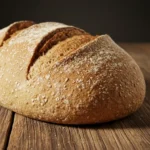White bread has been a household favorite for generations, known for its soft texture and versatility. Whether used for sandwiches, toast, or enjoyed plain, white bread remains a beloved choice in many kitchens.
In this article, we’ll delve into the nuances of white bread, starting with a comprehensive homemade recipe that brings bakery-quality loaves to your table.
Table of Contents
Table of Contents
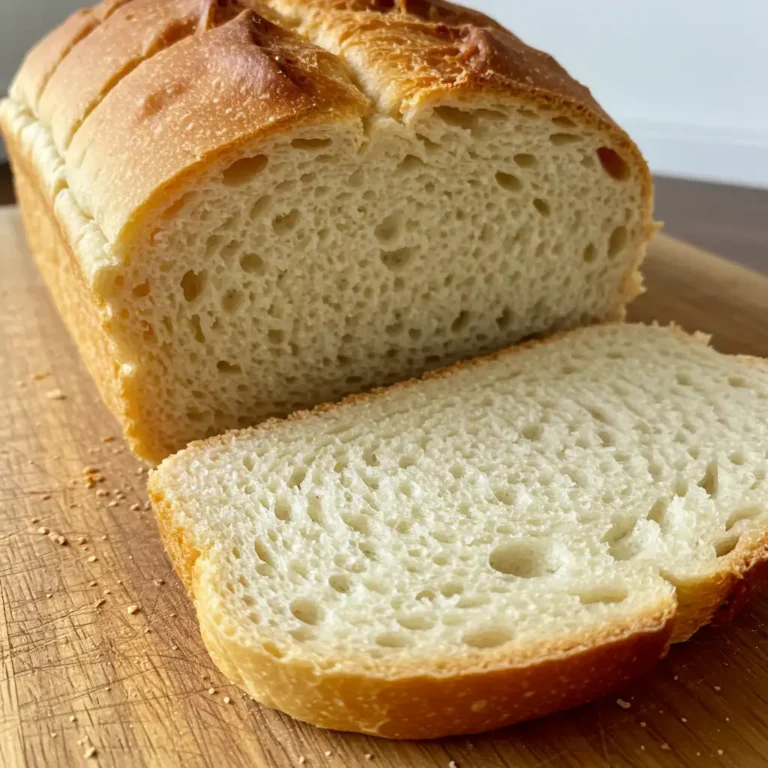
White Bread: A Classic Staple with Timeless Appeal
This homemade white bread recipe is soft, fluffy, and irresistibly comforting. Whether you’re crafting a classic sandwich, making toast for breakfast, or enjoying it fresh from the oven, this white bread delivers nostalgic flavor and satisfying texture. With simple ingredients and easy-to-follow steps, it’s perfect for beginners and experienced bakers alike.
- Total Time: 2 hours 20 minutes
- Yield: 1 loaf (about 12 slices) 1x
Ingredients
1 cup warm water (110°F/45°C)
2 ¼ tsp active dry yeast (1 packet)
2 tbsp granulated sugar
2 tbsp vegetable oil or melted butter
1 ½ tsp salt
3 to 3 ½ cups all-purpose flour (plus more for dusting)
Instructions
Activate the yeast:
In a large bowl, combine warm water and sugar. Sprinkle yeast over the top and let sit for 5–10 minutes, until foamy.Mix the dough:
Add oil and salt to the yeast mixture. Stir in 3 cups of flour, one cup at a time, until a soft dough forms. Add the remaining ½ cup if needed.Knead the dough:
Turn dough onto a floured surface and knead for 8–10 minutes until smooth and elastic. Alternatively, use a stand mixer with a dough hook.First rise:
Place the dough in a greased bowl, cover with a damp cloth, and let it rise in a warm spot for 1 to 1.5 hours, or until doubled in size.Shape the loaf:
Punch down the dough, shape it into a loaf, and place it into a greased 9×5-inch loaf pan.Second rise:
Cover the loaf with a clean towel and let rise for another 30–45 minutes until the dough has doubled again.Bake:
Preheat oven to 375°F (190°C). Bake for 30–35 minutes until the top is golden brown and sounds hollow when tapped.Cool:
Remove from pan and let cool on a wire rack for at least 20 minutes before slicing.
Notes
For a richer flavor, substitute half the water with milk.
Brush the top with melted butter after baking for a softer crust.
Store in an airtight container at room temperature for up to 3 days.
Freeze sliced white bread in a ziplock bag for up to 3 months.
- Prep Time: 15 minutes
- Cook Time: 35 minutes
- Category: Bread
- Method: Baking
- Cuisine: American
Nutrition
- Calories: 140 kcal
- Sugar: 2 g
- Sodium: 230 mg
- Fat: 3 g
- Saturated Fat: 0.5 g
- Unsaturated Fat: 2.5 g
- Trans Fat: 0 g
- Carbohydrates: 25 g
- Fiber: 1 g
- Protein: 4 g
- Cholesterol: 0 mg
Crafting the Perfect Homemade White Bread
Ingredients for White Bread
To create a delightful loaf of white bread, gather the following ingredients:
- 2 cups warm water (105°F to 110°F)
- 2 tablespoons granulated sugar
- 2 (0.25-ounce) packets active dry yeast
- 6 cups all-purpose flour
- 4 tablespoons unsalted butter, melted
- 2 teaspoons salt
Note: These ingredients are adapted from a trusted recipe .
Step-by-Step Guide to Making White Bread
- Activate the Yeast: In a large mixing bowl, combine warm water and sugar. Stir until the sugar dissolves. Sprinkle the yeast over the water and let it sit for about 5-10 minutes until it becomes frothy.
- Prepare the Dough: Add melted butter and salt to the yeast mixture. Gradually incorporate the flour, one cup at a time, mixing well after each addition. Continue until a soft dough forms.
- Knead the Dough: Transfer the dough to a floured surface and knead for about 8-10 minutes until it becomes smooth and elastic.
- First Rise: Place the dough in a greased bowl, cover it with a damp cloth, and let it rise in a warm place for about 1 to 1.5 hours, or until it doubles in size.
- Shape the Loaves: Punch down the risen dough and divide it into two equal portions. Shape each portion into a loaf and place them into greased 9×5-inch loaf pans.
- Second Rise: Cover the pans with a damp cloth and let the dough rise again for about 30-45 minutes, or until it rises slightly above the edges of the pans.
- Bake the Bread: Preheat your oven to 375°F (190°C). Bake the loaves for 25-30 minutes, or until they are golden brown and sound hollow when tapped.
- Cool and Serve: Remove the loaves from the pans and let them cool on wire racks. Slice and enjoy your homemade white bread!
Tips for the Best White Bread
- Consistent Temperature: Ensure your water is warm but not hot to activate the yeast effectively.
- Proper Kneading: Kneading develops gluten, which gives the bread its structure and chewiness.
- Patience with Rising: Allow the dough to rise adequately during both proofing stages for optimal texture.
- Storage: Store the cooled bread in an airtight container at room temperature for up to 3 days, or freeze for longer shelf life.
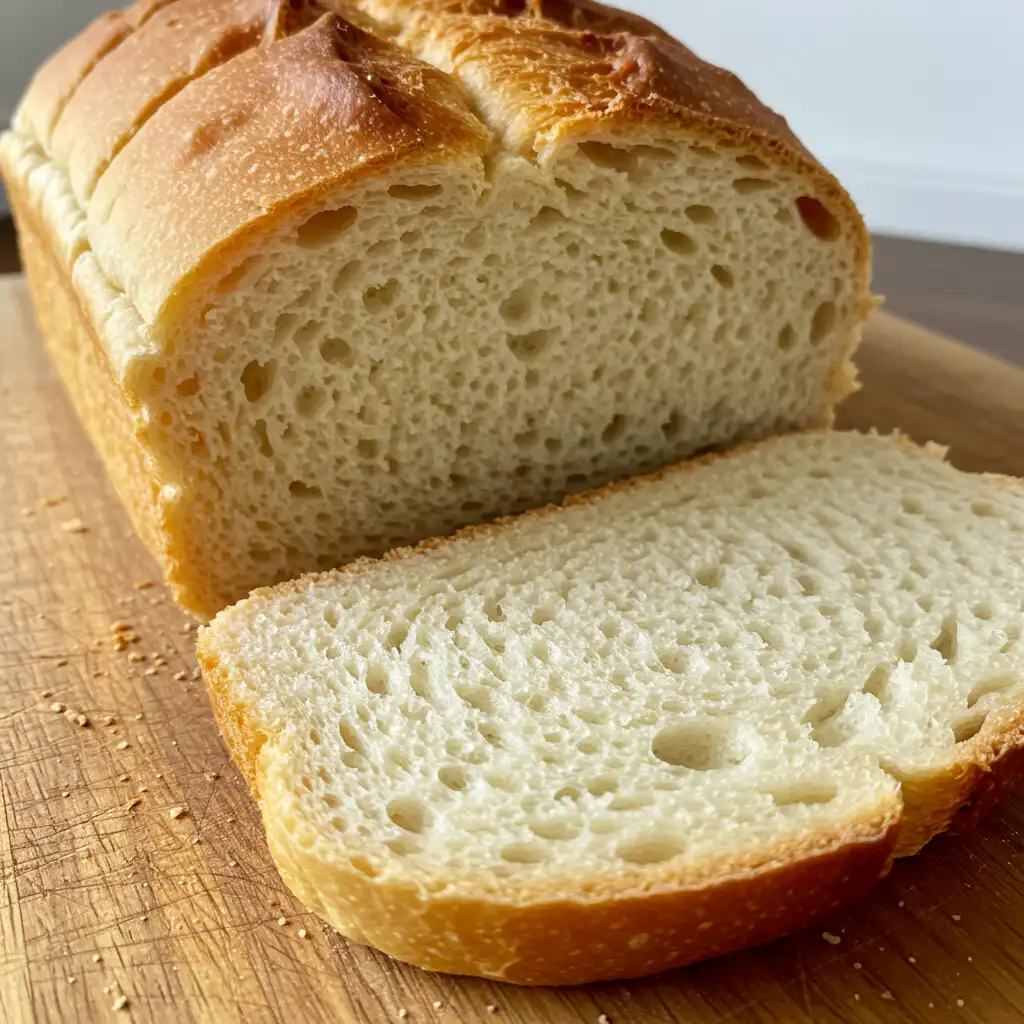
Is White Bread Healthy? Nutrition, Benefits, and Concerns
Nutritional Profile of White Bread
Let’s break down what’s really inside a typical slice of white bread. A single slice (approx. 25 grams) contains:
| Nutrient | Amount per Slice |
|---|---|
| Calories | 70–80 kcal |
| Carbohydrates | 13–15 grams |
| Sugars | 1–2 grams |
| Protein | 2–3 grams |
| Fat | 0.5–1 grams |
| Fiber | <1 gram |
| Sodium | 130–180 mg |
| Iron (fortified) | 4–6% DV |
| Folate (fortified) | 10–15% DV |
White bread often comes fortified with vitamins like folic acid and iron, making it more nutrient-dense than people might assume.
Is White Bread Good or Bad for You?
White bread often gets a bad rap — and not entirely without reason. But whether white bread is good or bad for you depends on a few factors:
- Pros:
- Convenient and affordable
- Often enriched with vitamins (iron, folic acid, etc.)
- Easily digestible, making it suitable for some digestive conditions
- Cons:
- Low in fiber compared to whole grain breads
- Can cause blood sugar spikes
- Highly processed, with fewer natural nutrients
That said, eating white bread in moderation won’t derail your health. It’s about the bigger picture — balance and frequency.
When Can White Bread Fit into a Healthy Diet?
Here are situations where white bread can be part of a smart, balanced meal:
- Pre/Post-Workout: Athletes eat white bread because it digests quickly, offering fast fuel.
- Sensitive Stomachs: White bread is often better tolerated during GI issues or after surgery.
- Kids’ Nutrition: Enriched white bread can provide iron and folate in children’s diets.
Risks of Eating Too Much White Bread
Overconsuming white bread may lead to:
- Weight gain if eaten excessively without balance
- Digestive issues, like constipation, due to low fiber
- Blood sugar spikes in people with insulin resistance or diabetes
- Colon health concerns, as it lacks fiber that supports gut function
Despite myths, white bread itself is not inherently harmful to your colon, but a fiber-poor diet overall can be.
How Often Is It Okay to Eat White Bread?
Most dietitians agree that 1–2 slices per day is fine — especially when balanced with whole foods like vegetables, protein, and healthy fats. The key is variety. If white bread is just one of many types of grains you enjoy, there’s little cause for worry.
What’s Better: White or Brown Bread?
This age-old debate often depends on your goals:
| Category | White Bread | Brown/Whole Wheat Bread |
|---|---|---|
| Fiber Content | Low | High |
| Digestibility | Easy | May cause bloating for some |
| Nutrients | Fortified (iron, folate) | Naturally higher in B-vitamins |
| Satiety | Short-term | Long-lasting |
| Glycemic Index | Higher | Lower |
Verdict: Whole wheat wins nutritionally — but white bread still holds a place in a balanced eating pattern, especially when fortified.
Common Misconceptions About White Bread
Let’s clear the air on some popular white bread myths:
- “White bread causes weight gain.” → Only if you eat it in excess without managing total calorie intake.
- “White bread is toxic.” → False. It’s not toxic — it’s simply less nutrient-dense.
- “White bread is banned by athletes.” → Nope. In fact, many athletes rely on it for quick carbs pre-training.
Healthy Ways to Enjoy White Bread
White bread can be a delicious base when paired wisely:
- Toasted with avocado and egg
- As a sandwich with turkey, lettuce, and tomato
- Spread with natural peanut butter and banana slices
- French toast made with egg and cinnamon
Just don’t make it the only carb in your life. Mix things up with brown rice, oats, and quinoa to keep meals balanced.
How to Choose the Best White Bread Brands and Smart Alternatives
What to Look for When Buying White Bread
Not all white bread is created equal. When browsing the bread aisle, here’s how to pick a better loaf of white bread without getting fooled by flashy packaging.
- Check the ingredients list
Look for white bread with fewer than 7 ingredients. A shorter list often means fewer preservatives, additives, and fillers. Watch out for high-fructose corn syrup or partially hydrogenated oils. - Look for “enriched” and “fortified”
Good white bread is often enriched with folic acid, iron, and B vitamins, which are essential — especially for kids, pregnant women, and older adults. - Watch the fiber
Some white bread brands now add fiber without changing the texture. Aim for at least 2 grams of fiber per slice, even if it’s still white bread. - Check the sugar content
Many commercial white breads contain hidden sugars. Choose options with less than 2g of sugar per slice if you want to keep things balanced. - Go for whole grain blends
Some white breads are labeled as “white whole wheat” or “white wheat” — these can be a great compromise. They still taste like white bread but offer more nutrients.
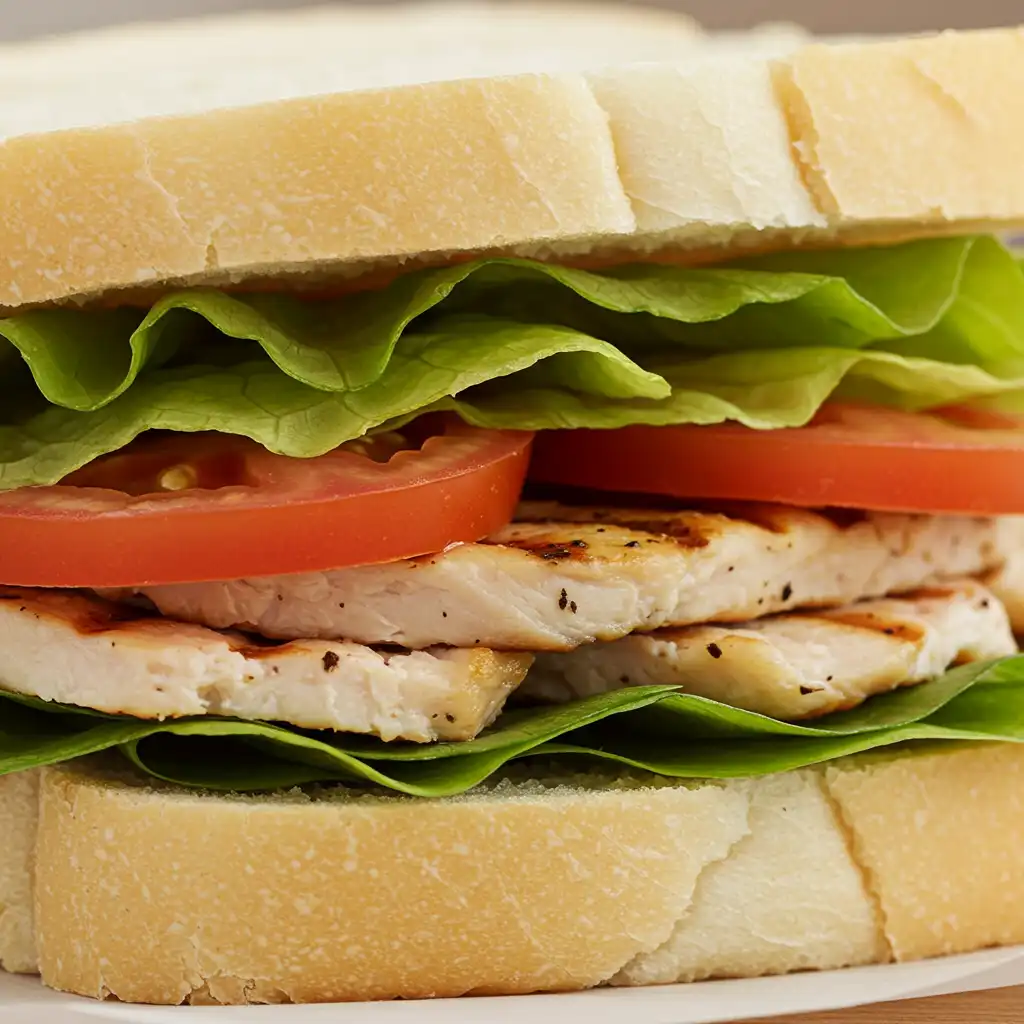
Best White Bread Brands in the U.S.
Based on nutrition, taste, and ingredient transparency, here are a few popular white bread brands that stand out:
| Brand Name | Notable Features |
|---|---|
| Sara Lee White Bread | Soft texture, enriched with calcium and folic acid |
| Pepperidge Farm Farmhouse White | Thicker slices, no artificial flavors or colors |
| Wonder Classic White Bread | Fortified with vitamins, kid-friendly taste |
| Nature’s Own Whitewheat | Blended with whole grains and fiber |
| Arnold Country White | Old-fashioned recipe with simple ingredients |
Pro Tip: Always check for freshness by squeezing the loaf — fresher white bread should bounce back when pressed.
Is Sara Lee White Bread Healthy?
Sara Lee white bread is one of the most widely available brands. It’s enriched with nutrients like calcium, folate, and iron, and contains 1 gram of fiber per slice. While it’s not a “health food,” it’s a decent choice for families looking for a soft, versatile white bread.
So yes, in moderation, Sara Lee white bread can be part of a healthy diet — especially when paired with protein or healthy fats to prevent blood sugar spikes.
Healthier Swaps for White Bread Lovers
Craving white bread but looking to make smarter choices? Try these alternatives:
- White whole wheat bread
Made from a lighter whole grain, it keeps the soft feel of white bread while adding nutrients. - Sourdough white bread
Lower glycemic index, easier to digest, and more natural fermentation. - Whole wheat pita or English muffins
Great for sandwiches or breakfast. - Sprouted grain bread
Contains whole, sprouted grains for more nutrients and fiber. - Gluten-free white bread (if needed)
For those with celiac disease or gluten sensitivity.
Should You Eat White Bread During Weight Loss?
While white bread isn’t banned from weight loss diets, portion control is key. If you’re in a calorie deficit and choosing nutrient-dense toppings, a slice or two of white bread a day is absolutely okay.
What matters more is what you pair your white bread with — think turkey and avocado instead of jam and butter.
What to Eat Instead of White Bread (When Cutting Back)
If you’re trying to eat less white bread, here are alternatives that offer more nutrients per bite:
- Quinoa or brown rice for bowls and sides
- Sweet potatoes for a naturally sweet carb
- Oatcakes or rice cakes for crunchy snacks
- Lettuce wraps for sandwiches and burgers
- Whole grain tortillas for flexible meals
White Bread and Your Body: Digestion, Blood Sugar, and Colon Health
How White Bread Affects Digestion
White bread is known for its ultra-soft texture and mild flavor, but that softness comes at a cost. Most white bread is made with refined flour, which lacks the fiber naturally found in whole grains. Without that fiber, digestion tends to slow down or become inconsistent.
- Lack of fiber
Fiber helps food move through your digestive tract. Since white bread contains very little fiber (usually less than 1g per slice), it can contribute to constipation or sluggish digestion, especially if your diet lacks other fiber-rich foods. - Fast digestion = fast hunger
White bread breaks down quickly in the stomach. This may leave you feeling hungry again within an hour, which can lead to overeating or unnecessary snacking. - Mild for sensitive stomachs
On the flip side, white bread is often recommended during recovery from stomach bugs, ulcers, or after medical procedures because it’s gentle on the gut.
So, while white bread is easy to digest, it doesn’t offer digestive benefits like its whole grain cousins.
Is White Bread a Laxative?
Surprisingly, many people believe that white bread acts like a mild laxative, but the truth is the opposite. Since it’s low in fiber and high in refined starches, white bread can lead to constipation rather than relieving it.
If you’re looking for a food to support bowel movements, choose high-fiber bread options instead — like whole wheat, flaxseed, or oat bread.
Is White Bread Bad for the Colon?
There’s growing concern about the link between diet and colon health, and refined carbs like white bread are part of the conversation.
Low fiber = higher risk
Fiber helps sweep the colon clean and supports a healthy gut microbiome. A high intake of white bread — without fiber-rich foods — could increase the risk of developing diverticulosis, colon polyps, or colorectal issues.
Increased inflammation
Diets high in refined starches may lead to low-grade inflammation in the gut. White bread, when eaten excessively, may contribute to this, especially if paired with processed meats or sugars.
White Bread and Blood Sugar Spikes
One of the most debated issues with white bread is its glycemic index (GI) — a measure of how quickly it raises your blood sugar.
- High glycemic index
White bread has a GI of around 70, meaning it digests rapidly and causes a quick rise in glucose. For people with prediabetes, diabetes, or insulin resistance, this spike can be harmful over time. - Energy crash effect
After the initial blood sugar spike comes a crash — leaving you feeling tired, hungry, and cranky. This roller coaster can make it harder to maintain a healthy diet. - Better balance with protein or fat
When you eat white bread with healthy fats or protein (like peanut butter, avocado, or eggs), the glycemic impact is reduced. So, you can still enjoy white bread — just pair it wisely.
Discover great ideas like these protein-packed toast toppings that balance blood sugar and taste amazing on white bread.
Is White Bread Safe for People with IBS or Digestive Disorders?
People with Irritable Bowel Syndrome (IBS) or inflammatory bowel diseases (IBD) often tolerate white bread better than whole grains — at least during flare-ups. Why?
Low residue
White bread is low in insoluble fiber, which can be irritating to inflamed intestines.
Soft texture
Easier to chew and digest, white bread can be soothing during periods of digestive distress.
However, it’s not a long-term solution. Adding back fiber gradually is critical for long-term gut health.
Can White Bread Cause Colon Polyps?
There’s no direct evidence that white bread causes colon polyps. However, diets low in fiber and high in refined carbs are associated with a higher risk of polyps and colorectal cancer over time.
So, while eating white bread occasionally won’t cause harm, relying on it daily without fiber-rich balance could put your colon health at risk.
Smart Tips to Improve Digestion When Eating White Bread
If you love your white bread and aren’t ready to give it up, try these tips to support digestion and colon health:
- Add fiber to your plate (salad, veggies, beans)
- Stay hydrated (aim for 8+ glasses of water daily)
- Use natural toppings (avocado, peanut butter, chia jam)
- Eat slowly and chew well
- Don’t eat white bread alone — pair with protein or fat
White Bread in Diets: Weight Loss, Athletes, and Everyday Eating
Can You Eat White Bread While Trying to Lose Weight?
When it comes to weight loss, white bread often gets a bad rap — but is that entirely fair?
- Calorie content
White bread typically contains about 70–80 calories per slice, which is similar to whole wheat bread. The problem isn’t calories alone, but how quickly those calories turn into energy and hunger. - Low fiber and satiety
Since white bread lacks fiber, it doesn’t keep you full for long. This can lead to overeating later, which may sabotage weight loss efforts. - Moderation is key
Eating white bread occasionally and in moderation won’t derail a weight loss plan, especially if balanced with proteins, healthy fats, and fiber-rich veggies. - Pairing for fullness
Add avocado, eggs, or lean turkey to your white bread sandwich. These add protein and fats that slow digestion and increase fullness.
Summary: White bread can fit into a weight loss plan — just watch portions and pair it wisely.
Why Do Athletes Eat White Bread?
Athletes often choose white bread over whole grain varieties, and there’s good reason behind it:
- Quick energy boost
White bread digests rapidly, providing a fast source of glucose that athletes need during or after intense workouts to replenish glycogen stores. - Easy on the stomach
During training or competition, athletes need foods that won’t upset their digestive system. White bread is soft, bland, and digestible, making it a safe choice. - Versatile base
It pairs well with energy-packed toppings like peanut butter, honey, or banana slices, offering balanced nutrition.
However, it’s not ideal as a sole source of carbs all the time. Athletes need a mix of complex carbs for sustained energy and whole grains for nutrients.
How Often Is It OK to Eat White Bread?
Eating white bread isn’t inherently bad if done in moderation and balanced with whole grains, fruits, vegetables, and proteins.
- General recommendation
Most nutritionists suggest limiting refined carbs, including white bread, to less than half your daily grain intake. - Listen to your body
If you notice bloating, fatigue, or cravings after eating white bread, consider reducing it. - Balance with fiber-rich foods
Incorporating high-fiber foods alongside white bread can offset some of the downsides.
Is White Bread Safe for Daily Consumption?
If you love white bread, is it safe to eat daily? The answer depends on your overall diet and health goals.
- For healthy adults
Eating 1–2 slices of white bread daily, especially when balanced with fiber and nutrient-rich foods, is generally safe. - For those with blood sugar concerns
Limit intake and monitor blood sugar levels, as white bread can cause spikes. - In weight management
Portion control and pairing with protein/fat are key to preventing overeating.

Comparing White Bread to Other Bread Types in Daily Diets
- White bread vs. brown bread
Brown bread has more fiber and nutrients but can be heavier on the stomach. - White bread vs. gluten-free bread
Gluten-free options may suit those with celiac disease but aren’t necessarily healthier for everyone. - White bread vs. sprouted grain bread
Sprouted breads offer better nutrition and digestion but may be costlier.
Tips for Including White Bread in a Balanced Diet
- Choose white bread brands that fortify with vitamins and minerals.
- Avoid white bread with added sugars or preservatives.
- Use white bread as a base for nutrient-dense meals — add lean proteins, veggies, and healthy fats.
- Mix up your grain intake — don’t rely on white bread exclusively.
Nutritional Profile of White Bread: Vitamins, Minerals, and Healthy Swaps
What Nutrients Are in White Bread?
White bread is a staple in many diets, but understanding its nutritional content is key to making informed choices.
- Calories and macronutrients
A typical slice of white bread contains around 70–80 calories, 13–15 grams of carbohydrates, 1–2 grams of protein, and about 1 gram of fat. - Carbohydrates and sugar
Most of the calories come from simple carbohydrates, which digest quickly and can cause blood sugar spikes if consumed alone. - Protein content
White bread has a modest protein content, but it lacks all essential amino acids, so it’s not a complete protein source. - Fiber content
Unfortunately, white bread is low in fiber—usually less than 1 gram per slice—which is why it doesn’t keep you full for long.
Vitamins and Minerals in White Bread
Many white breads are enriched or fortified to replace nutrients lost during processing, but they still fall short compared to whole grain breads.
- Enriched nutrients
Most white bread contains added iron, folic acid, and B vitamins such as thiamine, niacin, and riboflavin. These nutrients are essential for energy production and red blood cell health. - Calcium and magnesium
White bread has minimal calcium and magnesium, minerals important for bone health and muscle function. - Sodium levels
Watch out—some white breads can be high in sodium, which may be a concern if you’re monitoring blood pressure.
Healthy Swaps for White Bread
If you want to enjoy the texture and taste of white bread but boost nutrition, consider these healthier alternatives:
- Whole wheat bread
Higher in fiber, vitamins, and minerals, whole wheat bread slows digestion and improves satiety. - Sprouted grain bread
Made from sprouted whole grains, it has better nutrient absorption and digestion benefits. - Sourdough bread
Fermentation increases probiotics and reduces the glycemic index, making it easier on blood sugar. - Rye or multigrain bread
These options offer diverse nutrients and fiber, though watch out for added sugars.
How to Identify Healthy White Bread Options
Not all white bread is created equal. To choose healthier white bread:
- Check the ingredient list—look for simple ingredients like enriched flour, water, yeast, and minimal additives.
- Avoid breads with added sugars, preservatives, or high sodium.
- Opt for brands that fortify their bread with essential vitamins and minerals.
- Consider bread with added seeds or oats for extra fiber.
Does Fortified White Bread Count as Healthy?
While fortified white bread does replace some lost nutrients, it still lacks the fiber and phytochemicals found in whole grains. Therefore, it’s a better choice than non-fortified white bread but not as beneficial as whole grain options.
Can White Bread Fit Into a Balanced Diet?
Yes! White bread can be part of a balanced diet if:
It’s consumed alongside fiber-rich vegetables, lean proteins, and healthy fats.
You moderate portions to avoid excess refined carbs.
You alternate it with whole grain or sprouted breads for variety and nutrition.
Common Mistakes When Eating White Bread and Tips for Healthy Consumption
Mistake 1: Overeating White Bread Without Balancing Other Nutrients
One of the biggest pitfalls with white bread is consuming it without considering the rest of your meal.
- Lack of protein and fiber
Eating white bread alone or with sugary spreads can cause rapid blood sugar spikes and crashes. This often leads to hunger soon after eating. - Tip: Always pair white bread with protein sources like eggs, turkey, or peanut butter, and add veggies or fruits to boost fiber.
Mistake 2: Choosing White Bread with Hidden Sugars and Additives
Not all white bread is made equal—some brands pack their bread with added sugars, preservatives, and high sodium.
- Hidden sugars
These can contribute to unwanted calorie intake and impact blood sugar. - Tip: Read labels carefully and opt for brands with simple ingredients and no added sugar.
Mistake 3: Assuming White Bread is Always Unhealthy
Many believe white bread is inherently “bad,” but it depends on how it’s consumed and your overall diet.
- Context matters
Eating white bread occasionally as part of a balanced diet isn’t harmful. - Tip: Don’t demonize white bread—focus on moderation and balance.
Mistake 4: Ignoring Portion Sizes
Eating several slices of white bread a day can lead to excessive refined carb intake, which isn’t ideal for blood sugar control or weight management.
- Tip: Limit to 1–2 slices per meal and balance with fiber and protein.
Mistake 5: Not Considering Individual Health Conditions
People with diabetes, insulin resistance, or digestive issues may react differently to white bread.
- Tip: Monitor your body’s response and consult with a healthcare provider if needed.
Tips for Healthy White Bread Consumption
- Choose enriched white bread to get back some nutrients lost during processing.
- Balance your plate with veggies, proteins, and healthy fats.
- Alternate with whole grain or sprouted bread for better nutrition.
- Avoid white bread late at night to prevent blood sugar spikes.
- Watch your portions and listen to your hunger cues.
Storage Tips and Shelf Life: How to Keep White Bread Fresh Longer
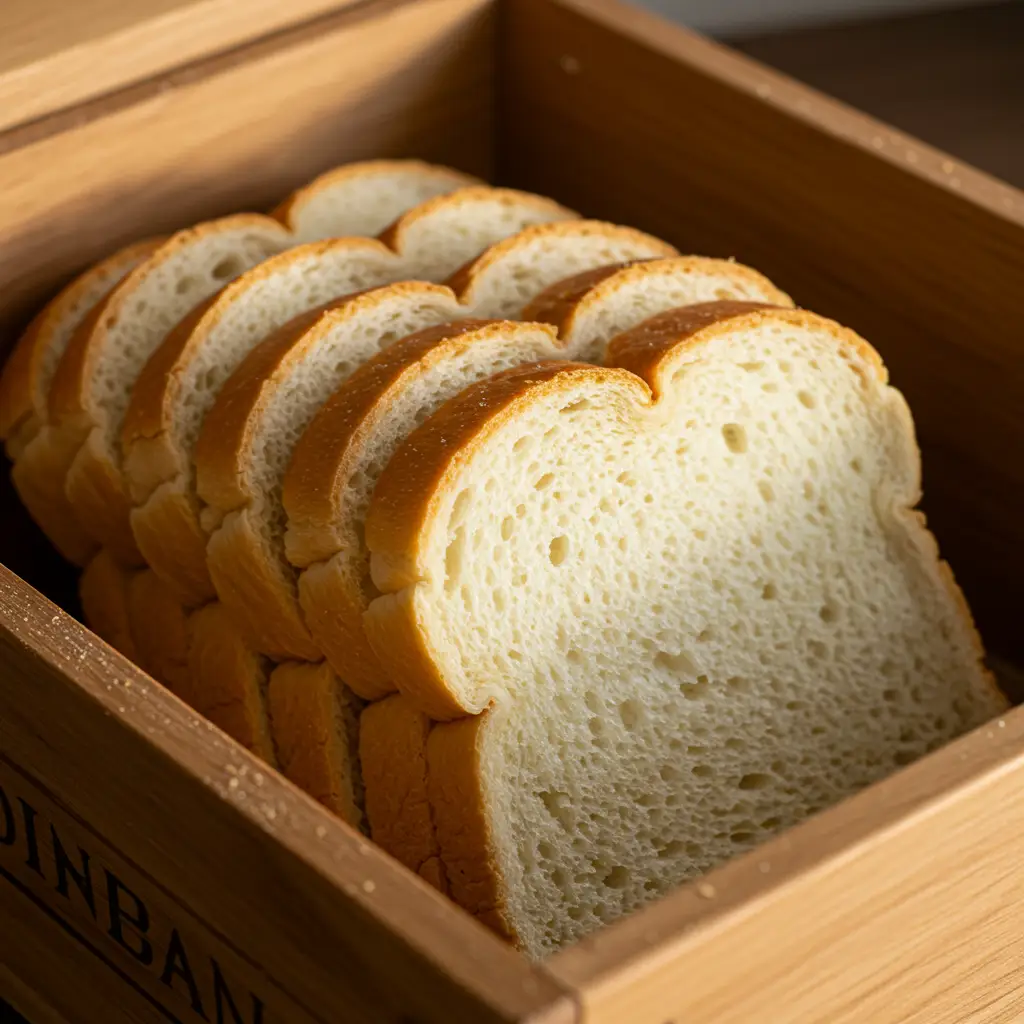
Understanding White Bread’s Shelf Life
White bread typically has a shorter shelf life compared to whole grain or sourdough breads due to its refined ingredients and lack of preservatives.
- Average shelf life
Store-bought white bread usually lasts about 5–7 days at room temperature when unopened. Once opened, it’s best consumed within 3–4 days. - Factors affecting freshness
Exposure to air, humidity, and temperature fluctuations speeds up staling and mold growth.
Best Practices for Storing White Bread
- Room temperature storage
Keep your white bread in a cool, dry place inside its original packaging or a bread box to protect it from air and moisture. - Avoid refrigeration
Refrigerating white bread causes it to dry out faster, leading to a stale texture. - Freezing for longer storage
If you don’t plan to consume white bread within a few days, freezing is your best option. Wrap slices tightly in plastic wrap or foil, then place in an airtight freezer bag. Frozen white bread can last up to 3 months without losing flavor.
How to Thaw Frozen White Bread Properly
- Thaw slices at room temperature or toast them directly from the freezer for best texture.
- Avoid microwaving bread as it makes it chewy and tough.
Signs That White Bread Has Gone Bad
- Mold growth (green, white, or black spots)
- Off smell or sour taste
- Excessive dryness or hard texture
Tips to Reduce Waste and Keep White Bread Fresh
- Buy smaller quantities if you eat bread slowly.
- Slice frozen bread as needed to avoid thawing the entire loaf.
- Use leftover white bread creatively: make breadcrumbs, croutons, or bread pudding.
Frequently Asked Questions (FAQs) About White Bread and Final Thoughts
Is white bread good or bad for you?
White bread provides quick energy and can fit into a balanced diet when eaten in moderation. While it lacks some nutrients compared to whole grain bread, it’s not inherently bad if balanced with proteins, fiber, and healthy fats.
Which bread is healthiest?
The healthiest breads tend to be whole grain, sprouted, or sourdough varieties. These contain more fiber, vitamins, and minerals than white bread, supporting digestion and sustained energy.
Which is better, white or brown bread?
Brown bread often has more fiber and nutrients than white bread. However, some brown breads contain added sugars or artificial coloring. Always check labels to choose the healthiest option.
Why do athletes eat white bread?
Athletes prefer white bread because it digests quickly, providing a fast source of carbohydrates to fuel performance and recovery.
How often is it OK to eat white bread?
Consuming white bread occasionally—about 2 to 3 times per week—is generally fine, especially if balanced with nutrient-rich foods and an active lifestyle.
Is white bread bad for your colon?
White bread lacks fiber, which is important for colon health, but eating it occasionally won’t cause harm. Maintaining a fiber-rich diet from fruits, vegetables, and whole grains is key.
What is the #1 healthy bread?
Whole grain bread made from 100% whole wheat or sprouted grains is often considered the healthiest bread option due to its nutrient profile.
What is the healthiest fruit?
Fruits high in fiber and antioxidants, like berries, apples, and oranges, are among the healthiest to complement a balanced diet including bread.
Why do people avoid white bread?
Many avoid white bread because it is a refined carb with lower fiber and nutrients, which can lead to blood sugar spikes and less satiety compared to whole grain options.
Can we eat white bread during weight loss?
Yes, white bread can be part of a weight loss plan if eaten in moderation and paired with protein and fiber to control hunger and blood sugar.
Final Thoughts on White Bread
White bread has earned a mixed reputation, but the truth lies in how and how much you consume it. It’s a versatile, convenient carbohydrate source that can fit healthily into your diet when eaten wisely. Focus on balance, portion control, and combining white bread with nutrient-rich foods to enjoy its benefits without drawbacks.
Did You Try Our Recipe?
There are no reviews yet. Be the first one to write one.




